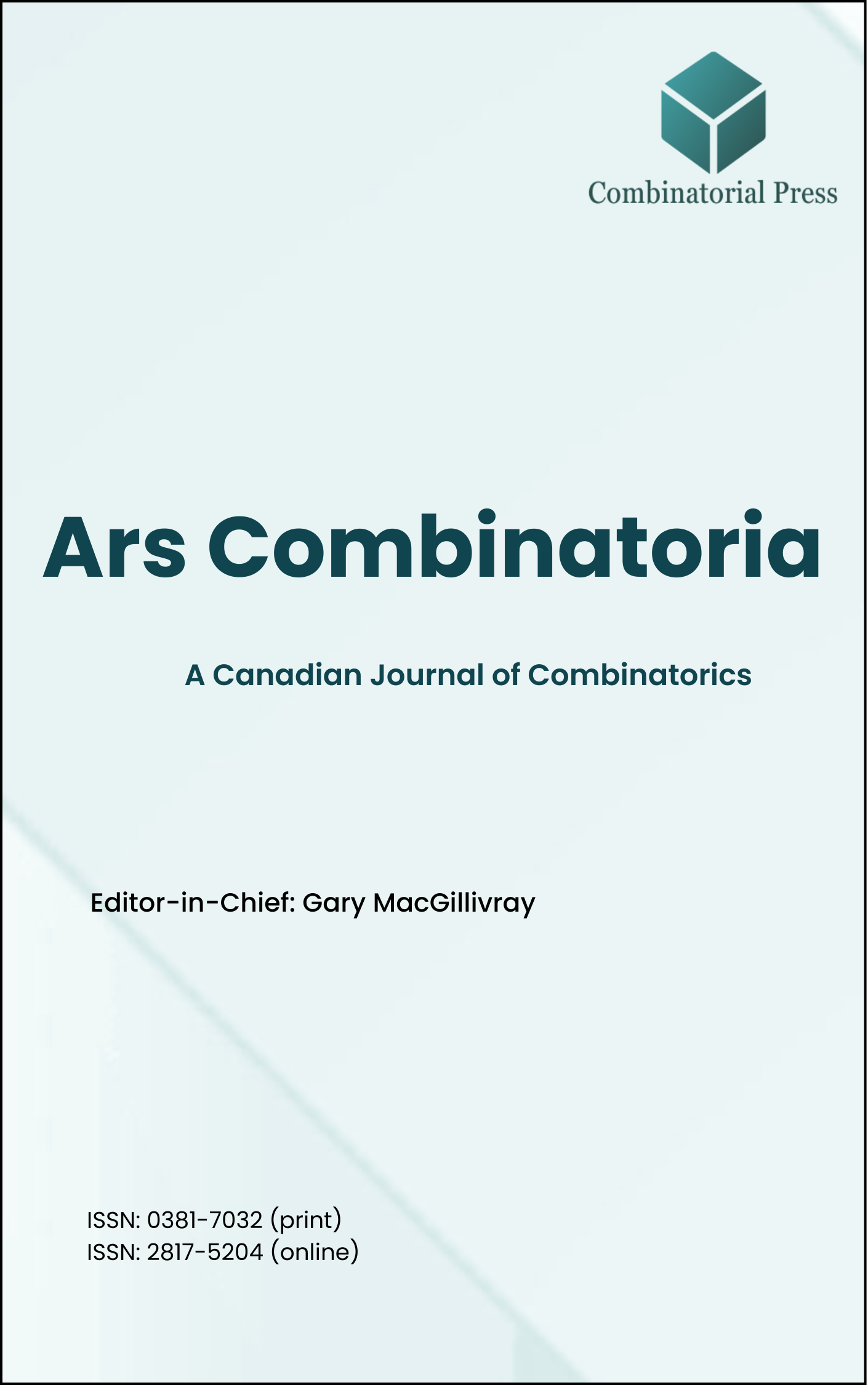
Ars Combinatoria
ISSN 0381-7032 (print), 2817-5204 (online)
Ars Combinatoria is the oldest Canadian Journal of Combinatorics, established in 1976. The journal is dedicated to advancing the field of combinatorial mathematics through the publication of high-quality research papers. From 2024 onward, it publishes four volumes per year in March, June, September and December. Ars Combinatoria has gained recognition and visibility in the academic community and is indexed in renowned databases such as MathSciNet, Zentralblatt, and Scopus. The Scope of the journal includes Graph theory, Design theory, Extremal combinatorics, Enumeration, Algebraic combinatorics, Combinatorial optimization, Ramsey theory, Automorphism groups, Coding theory, Finite geometries, Chemical graph theory but not limited.
Information Menu
- Research article
- Full Text
- Ars Combinatoria
- Volume 034
- Pages: 97-106
- Published: 31/12/1992
The notion of a regular tournament is generalized to \(r\)-tournaments. By means of a construction, it is shown that if \(n \mid \binom{n}{r}\) and \((n,r) = p^k\), where \(p\) is a prime, and \(k \geq 0\), then there exists a regular \(r\)-tournament on \(n\) vertices.
- Research article
- Full Text
- Ars Combinatoria
- Volume 034
- Pages: 93-95
- Published: 31/12/1992
We characterize those digraphs that are the acyclic intersection digraphs of subtrees of a directed tree. This is accomplished using the semilattice of subtrees of a rooted tree and the reachability relation.
- Research article
- Full Text
- Ars Combinatoria
- Volume 034
- Pages: 75-92
- Published: 31/12/1992
Let \(G = (V, E)\) be a finite, simple graph. For a triple of vertices \(u, v, w\) of \(G\), a vertex \(x\) of \(G\) is a median of \(u, v\), and \(w\) if \(x\) lies simultaneously on shortest paths joining \(u\) and \(v\), \(v\) and \(w\), and \(w\) and \(u\) respectively. \(G\) is a median graph if \(G\) is connected, and every triple of vertices of \(G\) admits a unique median. There are several characterizations of median graphs in the literature; one given by Mulder is as follows: \(G\) is a median graph if and only if \(G\) can be obtained from a one-vertex graph by a sequence of convex expansions. We present an \(O(|V|^2 \log |V|)\) algorithm for recognizing median graphs, which is based on Mulder’s convex-expansions technique. Further, we present an \(O(|V|^2 \log |V|)\) algorithm for obtaining an isometric embedding of a median graph \(G\) in a hypercube \(Q_n\) with \(n\) as small as possible.
- Research article
- Full Text
- Ars Combinatoria
- Volume 034
- Pages: 65-73
- Published: 31/12/1992
Let \(D_\Delta(G)\) be the Cayley colored digraph of a finite group \(G\) generated by \(\Delta\). The arc-colored line digraph of a Cayley colored digraph is obtained by appropriately coloring the arcs of its line digraph. In this paper, it is shown that the group of automorphisms of \(D_\Delta(G)\) that act as permutations on the color classes is isomorphic to the semidirect product of \(G\) and a particular subgroup of \(Aut\;G\). Necessary and sufficient conditions for the arc-colored line digraph of a Cayley colored digraph also to be a Cayley colored digraph are then derived.
- Research article
- Full Text
- Ars Combinatoria
- Volume 034
- Pages: 55-64
- Published: 31/12/1992
Chvatal [1] presented the conjecture that every \(k\)-tough graph \(G\) has a \(k\)-factor if \(G\) satisfies trivial necessary conditions. The truth of Chvatal’s conjecture was proved by Enomoto \({et\; al}\) [2]. Here we prove the following stronger results: every
\(k\)-tough graph satisfying trivial necesary conditions has a k-factor which contains an arbitrarily given edge if \(k \geq 2\), and also has a \(k\)-factor which does not contain an arbitrarily given edge \(v(k \geq 1)\).
- Research article
- Full Text
- Ars Combinatoria
- Volume 034
- Pages: 47-53
- Published: 31/12/1992
Szemerédi’s density theorem extends van der Waerden’s theorem by saying that for any \(k\) and \(c\), \(0 < c < 1\), there exists an integer \(n_0 = n_0(k, c)\) such that if \(n > n_0\) and \(S\) is a subset of \(\{1, 2, \ldots, n\}\) of size at least \(cn\) then \(S\) contains an arithmetic progression of length \(k\). A “second order density” result of Frankl, Graham, and Rödl guarantees that \(S\) contains a positive fraction of all \(k\)-term arithmetic progressions. In this paper, we prove the analogous result for the Gallai-Witt theorem, a multi-dimensional version of van der Waerden’s theorem.
- Research article
- Full Text
- Ars Combinatoria
- Volume 034
- Pages: 33-46
- Published: 31/12/1992
- Research article
- Full Text
- Ars Combinatoria
- Volume 034
- Pages: 25-31
- Published: 31/12/1992
This paper discusses the chromatic number of the products of \(n+1\) -chromatic hypergraphs. The following two results are proved:
Suppose \(G\) and \(H\) are \(n+ 1\) -chromatic hypergraphs such that each of \(G\) and \(H\) contains a complete sub-hypergraph of order n and each of \(G\) and \(H\) contains a vertex critical \(n + 1\)-chromatic sub-hypergraph which has non-empty intersection with the corresponding complete sub-hypergraph of order \(n\). Then the product \(G \times H\)is of chromatic number \(n + 1\).
Suppose \(G\) is an \(n+ 1\)-chromatic hypergraph such that each vertex of \(G\) is contained in a complete sub-hypergraph of order n. Then for any \(n + 1\)-chromatic hypergraph \(H\), \(G \times H \) is an \(n + 1\)-chromatic hypergraph.
- Research article
- Full Text
- Ars Combinatoria
- Volume 034
- Pages: 17-24
- Published: 31/12/1992
A set \(S\) is called \(k\)-multiple-free if \(S \cap kS = \emptyset\), where \(kS = \{ks : s \in S\}\). Let \(N_n = \{1, 2, \ldots, n\}\). A \(k\)-multiple-free set \(M\) is maximal in \(N_n\) if for any \(k\)-multiple-free set \(A\), \(M \subseteq A \subseteq N_n\) implies \(M = A\). Let
\[A(n, k) = \{|M| : M \subseteq N_n is maximal k -multiple-free\}\].
Formulae of \(\lambda(n,k)= \max \Lambda(n, k)\) and \(\mu(n, k) = \min \Lambda(n, k)\) are given. Also, the condition for \(\mu(n, k) = \Lambda(n, k)\) is characterized.
- Research article
- Full Text
- Ars Combinatoria
- Volume 034
- Pages: 3-15
- Published: 31/12/1992
We enumerate various families of planar lattice paths consisting of unit steps in directions \( {N}\), \({S}\), \({E}\), or \({W}\), which do not cross the \(x\)-axis or both \(x\)- and \(y\)-axes. The proofs are purely combinatorial throughout, using either reflections or bijections between these \({NSEW}\)-paths and linear \({NS}\)-paths. We also consider other dimension-changing bijections.





